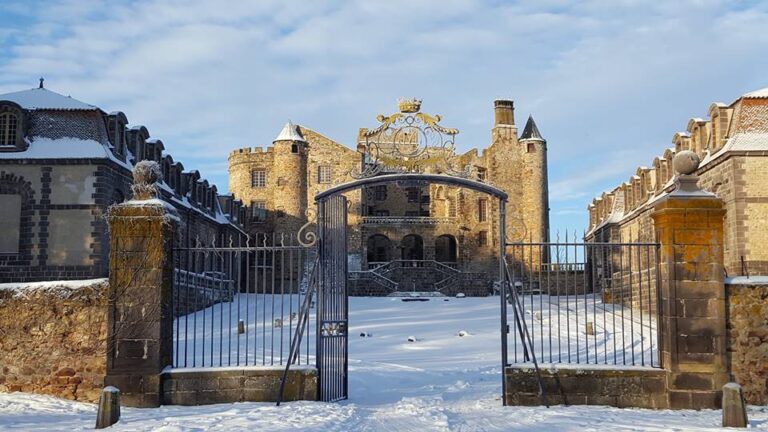Château de Veauce: A Medieval Fortress in France
Visitor Information
Google Rating: 4.1
Popularity: Very Low
Google Maps: View on Google Maps
Official Website: www.chateaudeveauce.fr
Country: France
Civilization: Unclassified
Remains: Military
History
The Château de Veauce is a medieval fortress situated in the village of Veauce in France. It was constructed by Frankish builders during the early Middle Ages.
The site originally hosted a Benedictine convent before the establishment of the castle. The initial fortress likely arose around 808 AD, a period coinciding with Charlemagne’s reorganization of the Aquitaine kingdom’s borders. This early phase laid the groundwork for the castle’s long-standing strategic presence. In the 11th century, the castle was rebuilt, reflecting evolving defensive needs, and further substantial modifications were made during the 13th century.
During the 12th century, ownership of the castle fell to the Bourbon family, an influential noble house. In 1400, Louis II de Bourbon elevated Veauce’s lordship to a barony, bestowing it upon Robert Dauphin, a knight who also held the lordship of Royne. The castle remained under Bourbon influence until the death of Charles III de Bourbon in 1527, after which it came under direct control of the French crown.
Between the 18th and mid-20th centuries, the Château de Veauce passed through the hands of several notable families, including Chauvigny de Blot, Le Loup, Du Buysson, and eventually the Cadier de Veauce family. By the mid-19th century, the castle had deteriorated significantly. Baron Charles de Cadier de Veauce, who served as a deputy for the Allier department, undertook major renovations from 1841 to 1846. His work reshaped much of the castle’s current appearance, including structural enhancements and aesthetic updates.
In the late 20th century, the castle changed ownership several times. It was acquired in 1971 by Ephraïm Tagori de la Tour, a British army officer and engineer. Following his death in 1998, the castle’s condition declined until 2002 when Elisabeth Mincer, another British citizen, became its owner. In 2015, a nonprofit organization was established with the mission to preserve the castle and foster cultural engagement; this fund was renamed Universum in 2023.
Beyond its documented history, the castle is linked to a local legend about Lucie, a young servant who reportedly died while imprisoned in the tower that houses the castle’s clock during the 16th century. Interest in this tale revived in the 1980s, especially after paranormal investigations and media reports drew attention to the site.
Since the 1980s and continuing into the 2010s, various parts of the castle and its associated buildings have received official heritage protection, recognizing their historical value.
Remains
The Château de Veauce is a fortified complex primarily dating from the 11th through 14th centuries, arranged around a central courtyard known as the “cour d’honneur.” Buildings within the castle are connected by a covered wall-walk, called a chemin de ronde, allowing defenders to move along the ramparts under cover.
One of the oldest features is a tower positioned at the northwest corner, originating in the 11th century. This tower includes an assommoir—a murder hole used to defend entrances from above—and an observation slit designed for archers. A bell is also part of this tower’s construction, emphasizing its role in both defense and signaling.
Also on the northwest side stands the tallest tower of the castle, built in the 13th century and rising to 45 meters. This watchtower overlooks the southern and eastern approaches, including sightlines toward the nearby area of Gannat. Its base is circular and constructed from Charroux stone, a local limestone rich in fossils, chosen for its durability.
The donjon, or keep, lies to the northeast and features four levels, counting the ground floor. It is colloquially called “La tour mal-coiffée” because its battlements on the southern summit were never fully completed. Around 1850, during the 19th-century renovations, the donjon was heightened, along with extensions to the clock tower and roofing added to the wall-walk. In 2006, a partial collapse of this tower damaged the roof of the northern wing and led to vegetation growing inside the keep.
The clock tower on the eastern side began as a 13th-century guard tower but was extended in the mid-1800s. It is sometimes referred to as the “tour de Lucie” due to its connection with the historical legend of Lucie, as well as its subsequent focus in paranormal studies during the 20th century.
On the southern side stands a tower dating from the 16th century that is attached to the main complex. It contains only a spiral staircase, which provides vertical access to the castle’s floors rather than serving a defensive function.
A significant change occurred in the 15th century when part of the northern defensive walls was dismantled to create a residence along the edge of a ravine. This residence retains a medieval appearance, marked by stone mullioned windows and a stair turret flanking the building.
In addition to these primary structures, a small, miniature castle known as the tournebride or manoir des Noix dates from the same period as the main towers and stands as part of the estate.
Terraces were added outside the fortifications in the 17th or 18th century, expanding the castle grounds. In the 19th century, the main building was rebuilt with a new gatehouse, replacing an earlier structure and reflecting architectural changes of that era.
The castle’s surroundings include gardens to the south and east, a forest called Colettes to the west, and the village of Veauce to the northeast. The estate encompasses several ancillary buildings, such as the manor of Noix, a dovecote, stables, a wine cellar, a dairy, a huntsman’s house, and a kennel. These structures have been recognized as historic monuments, highlighting the comprehensive nature of the castle complex and its associated lands.









